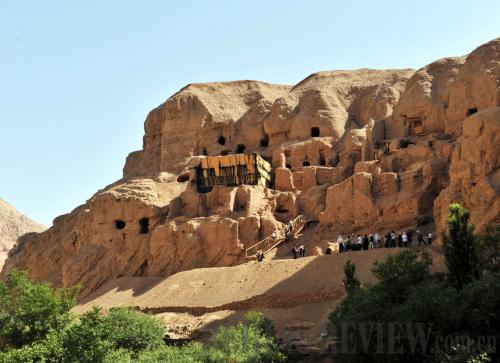|
The Lu Family Cemetery in Lantian, Shaanxi Province
Four generations of the Lu Family, including Lu Dalin (1040-1092), an ancient bronzeware expert, considered the father of Chinese archaeology, and his brothers were interred in the graveyard between 1074 and 1111.
It has been the most complete family cemetery found in China today. Archaeologists found nearly 700 cultural relics in the graveyard, including porcelain, pottery, stone, steel, bronze, tin, gold, silver and lacquered objects.
The family graveyard can help shed a lot of light on the social and cultural life of the upper classes during the Northern Song Dynasty (960-1127).
The Mudu City Site in Suzhou, Jiangsu Province
The site is located in a basin in the southwest of Suzhou. Excavation began in late 2009, and the findings show it was an ancient city of the Spring and Autumn Period (770-476 B.C.). City walls, water ways and a large number of artifacts including ceramic shreds with stamped designs, tiles, bronze arrowheads, and protoporcelain bowls have been discovered at the site. The tile was an important building material of high-class architecture during the period and had not been found in southeast China before. Archaeologists also found a large number of earth-mount tombs and stone-chamber earth-mount tombs of the same period in the surrounding areas. All these discoveries indicate the site in the mountain area in southwest Suzhou might have been the large center of a settlement group with settlements of different sizes and tombs, and probably a capital in the late Spring and Autumn Period. These discoveries are important for a better understanding of the social development in the Suzhou area during the period.
The Dahekou Cemetery in Yicheng, Shanxi Province
The cemetery covers an area of 4 hectares and contains more than 1,000 funeral plots. A total of 615 graves, 22 chariot and horse pits, together with abundant bronze, ceramic vessels, jade objects and lacquer, tin and gold objects have been discovered in the 1.5-hectare excavated area. The inscriptions on bronze vessels indicate that the cemetery might be the national cemetery of the Ba State during the Western Zhou Dynasty (11th century-771 B.C.). The cemetery is important for research on burial systems in the dynasty.
The Fengqiyuan Family Cemetery In Xi'an, Shaanxi Province
This family cemetery is situated on the Fengqiyuan Plain to the south of Xi'an. The cemetery, which covers an area of nearly 61,600 square meters, was found in 2007. It is a large cemetery centering around a graveyard built for General Zhang Anshi during the reigning period of Emperor Xiaoxuan (74-49 B.C.) of the Western Han Dynasty (202 B.C.-A.D. 9). With excavation approaching its end in 2010, the nature of the cemetery has been further clarified. Valuable remains together with more than 600 objects, including gold, bronze, iron, primitive porcelain, pottery, and jade objects, have been discovered, proving the mausoleum complex is of great historical and academic value.
The Tuyugou Grottos and Monastery Site in Shanshan, Xinjiang Uygur Autonomous Region
 |
|
MAGIC CAVES: Great discoveries are obtained in the excavation of the Tuyugou Grottoes in Shanshan, Xinjiang Uygur Autonomous Region, on May 23 (JIANG WENYAO) |
The Tuyugou Grottoes are the earliest Buddhist grottoes in the Turpan area. The artwork in the grottoes was created between the 4th and 13th centuries, spanning more than 1,000 years.
The grottos are important for the study of the spread of Buddhist art in China from south to north and from west to east. The large number of documents discovered from the site are significant for research on the social life, religion, culture as well as ancient linguistics in this area.
|
